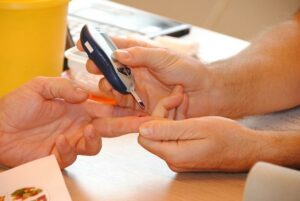Diabetic shock is a critical condition that can occur in individuals with diabetes. It results from extremely low blood sugar levels and requires immediate medical attention. This comprehensive guide aims to educate readers about diabetic shock, including its causes, symptoms, and essential treatment strategies. Whether you’re a diabetic patient, a caregiver, or just someone looking to expand your health knowledge, this blog will provide valuable insights into diabetic shock treatment and responding effectively to this potentially life-threatening condition.
Contents
What Is Diabetic Shock?
 Diabetic shock is a critical condition that arises primarily in individuals with diabetes, particularly those who are insulin-dependent. This condition occurs when blood sugar levels drop dangerously low, a state known as hypoglycemia. The human body relies on glucose, a type of sugar, as its primary energy source. In people with diabetes, maintaining a balanced blood glucose level is crucial, as their bodies either don’t produce enough insulin (as in Type 1 diabetes) or cannot use insulin effectively (as in Type 2 diabetes).
Diabetic shock is a critical condition that arises primarily in individuals with diabetes, particularly those who are insulin-dependent. This condition occurs when blood sugar levels drop dangerously low, a state known as hypoglycemia. The human body relies on glucose, a type of sugar, as its primary energy source. In people with diabetes, maintaining a balanced blood glucose level is crucial, as their bodies either don’t produce enough insulin (as in Type 1 diabetes) or cannot use insulin effectively (as in Type 2 diabetes).
The term “shock” in this context doesn’t necessarily mean emotional shock. But rather refers to the body’s physiological response to the acute lack of glucose needed for cellular function. In a state of diabetic shock, a person may experience a range of symptoms including confusion, unusual behavior, visual disturbances, and even loss of consciousness. If not addressed promptly, it can result in severe complications and potentially life-threatening outcomes.
What To Do During Diabetic Shock?
When encountering a diabetic shock, or severe hypoglycemia, it’s crucial to act quickly and efficiently to prevent serious complications. Here’s what you should do:
- Recognize the Symptoms: First, recognize the signs of diabetic shock which can include confusion, dizziness, sweating, shaking, altered behavior, rapid heartbeat, fainting, or seizures.
- Check Blood Sugar Levels: If possible, check the person’s blood sugar level using a glucose meter. A reading below 70 mg/dL is generally considered hypoglycemic and indicates a need for immediate action.
- Administer Fast-Acting Sugar: If the individual is conscious and able to swallow, provide a fast-acting source of sugar. This can be glucose tablets, fruit juice, regular (not diet) soda, honey, candy, or anything similar. Avoid foods with fat like chocolate, as fat can slow down the absorption of sugar.
- Retest Blood Sugar Levels: After 15 minutes, recheck the blood sugar level. If it is still low, administer another dose of fast-acting sugar.
- Continue Monitoring: Keep monitoring the individual. If they don’t improve quickly, or if symptoms worsen, seek immediate medical assistance.
- Seek Emergency Help if Necessary: If the person is unconscious, unresponsive, or having a seizure, do not try to give them anything orally as it could cause choking. Instead, if available, use a glucagon injection if you are trained to do so, and call emergency services immediately.
- After Treatment: Once the person recovers, they should eat a meal or snack that contains long-acting carbohydrates and protein to help stabilize their blood sugar levels.
Remember, in cases of diabetic shock, every second counts. Quick and appropriate action can save lives and prevent serious complications. If you’re unsure about the right course of action, err on the side of caution and seek professional medical help immediately.
What Are The Best Diabetic Shock Treatment?
 The best diabetic shock treatment, or severe hypoglycemia, primarily focuses on quickly raising the blood sugar to safe levels. The approach varies depending on the severity of the hypoglycemia and whether the person is conscious or unconscious. Here’s an overview of the medical approaches:
The best diabetic shock treatment, or severe hypoglycemia, primarily focuses on quickly raising the blood sugar to safe levels. The approach varies depending on the severity of the hypoglycemia and whether the person is conscious or unconscious. Here’s an overview of the medical approaches:
Immediate Treatment for Conscious Individuals
- Fast-Acting Carbohydrates: The primary goal is to rapidly increase blood glucose levels. Around 15-20 grams of fast-acting carbs are typically recommended. It’s important to note that overtreatment can lead to hyperglycemia, so moderation is key.
- Follow-up with Complex Carbohydrates: After the initial treatment with fast-acting sugars, it’s important to consume a snack or meal that includes complex carbohydrates and protein. This helps stabilize blood sugar levels and prevents a recurrence of hypoglycemia. Options include a sandwich, a small meal, or a snack bar.
Emergency Treatment for Unconscious Individuals
- Glucagon Injection: This is a critical intervention. Glucagon kits are available by prescription and should be kept on hand by those at risk. Training on how to use these kits is essential for the patient and their caregivers.
- Medical Attention: Immediate medical attention is crucial. Even after administering glucagon, the underlying cause of the hypoglycemic episode needs to be identified and treated.
Hospital Treatment
- Intravenous Glucose: In severe cases, particularly if the response to glucagon is inadequate, intravenous glucose may be administered in a hospital setting. This is a quick way to elevate blood sugar levels under medical supervision.
Monitoring and Adjustment of Diabetes Management
- Medication Adjustment: Often, adjustments to insulin or other diabetes medications are necessary. This might involve changing the dose, timing, or type of medication.
- Lifestyle Considerations: Factors like diet, exercise, and alcohol consumption can affect blood sugar levels. A healthcare provider can offer guidance on managing these factors.
Education and Training
- Ongoing Education: Understanding the factors that lead to hypoglycemia is crucial. This includes education on diet, exercise, medication interactions, and how to adjust insulin doses.
- Training for Others: It’s vital that people who are regularly around the diabetic patient – like family members, friends, and colleagues – know how to recognize the signs of hypoglycemia and how to act in an emergency.
Continuous Glucose Monitoring (CGM)
- Real-time Blood Sugar Readings: CGMs offer continuous feedback on glucose levels, helping to identify trends and prevent episodes of hypoglycemia.
- Alerts and Alarms: These devices can alert the user to rapidly dropping blood sugar levels before they reach a critical point.
Regular Review and Adjustment
- Regular Health Check-ups: Regular appointments with a healthcare provider to review and adjust the diabetes management plan are essential.
- Personalized Management Strategies: Management plans should be tailored to individual needs, considering factors like age, lifestyle, and the presence of any other health conditions.
It’s important to remember that while these treatments are effective in managing diabetic shock, prevention through careful monitoring of blood sugar levels and adherence to a diabetes management plan is crucial. Always consult a healthcare provider for personalized advice and treatment plans.
What Are The Risks Of Diabetic Shock?
 Diabetic shock poses several risks and potential complications. That can be serious if not promptly addressed. Understanding these risks is crucial for individuals managing diabetes and their caregivers. Here are the key risks associated with diabetic shock:
Diabetic shock poses several risks and potential complications. That can be serious if not promptly addressed. Understanding these risks is crucial for individuals managing diabetes and their caregivers. Here are the key risks associated with diabetic shock:
- Loss of Consciousness
One of the most immediate and dangerous risks of diabetic shock is the loss of consciousness. If blood sugar levels fall too low, the brain does not receive enough glucose to function properly, leading to fainting or seizures.
- Seizures
Severe hypoglycemia can cause seizures, which are not only dangerous at the moment but can also have long-term neurological implications.
- Accidents and Injuries
The altered mental state caused by low blood sugar can lead to accidents, such as falls or car crashes, especially if the individual is engaged in activities like driving or operating machinery.
- Brain Damage
Prolonged hypoglycemia can lead to irreversible brain damage. The brain relies heavily on glucose as its primary energy source, and without it, brain cells can be permanently damaged.
- Heart Problems
Severe hypoglycemia can cause cardiac arrhythmias (irregular heartbeats) and even heart attacks, particularly in individuals with existing heart disease.
- Psychological Impact
The fear of experiencing diabetic shock can lead to anxiety and stress, impacting the individual’s overall quality of life. This can also lead to over-cautiousness, resulting in consistently higher blood sugar levels to avoid hypoglycemia, which in turn can lead to other complications associated with hyperglycemia.
Due to these risks, effective management and prevention of hypoglycemia are critical components of diabetes care. Regular monitoring of blood glucose levels, adhering to a diabetes management plan, and educating oneself and others about the signs, symptoms, and diabetic shock treatment are essential strategies.
Conclusion
In conclusion, diabetic shock, a serious condition arising from extremely low blood sugar levels, poses significant risks to individuals with diabetes. It’s crucial to understand and recognize its symptoms, such as confusion, dizziness, and unconsciousness, as timely and appropriate responses can be life-saving. By incorporating strategies of diabetic shock treatment, being prepared with fast-acting carbohydrates, and educating oneself and others about emergency treatments, individuals with diabetes can manage their condition effectively.
Remember, awareness, preparedness, and proactive management are key to successfully navigating the challenges of diabetes and reducing the risks associated with diabetic shock. Do you want to get rid of diabetes? Join our online diabetes treatment program and reverse Diabetes naturally through lifestyle changes such as a Personalized Diet plan, Exercise, Yoga, dieticians, and health coaches.

